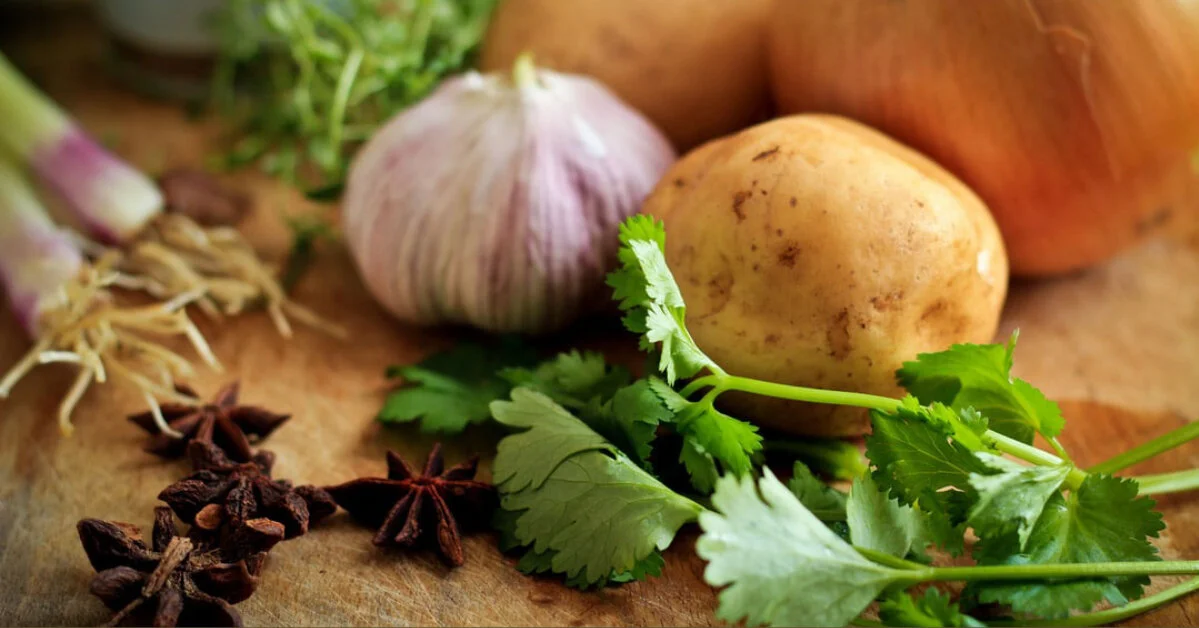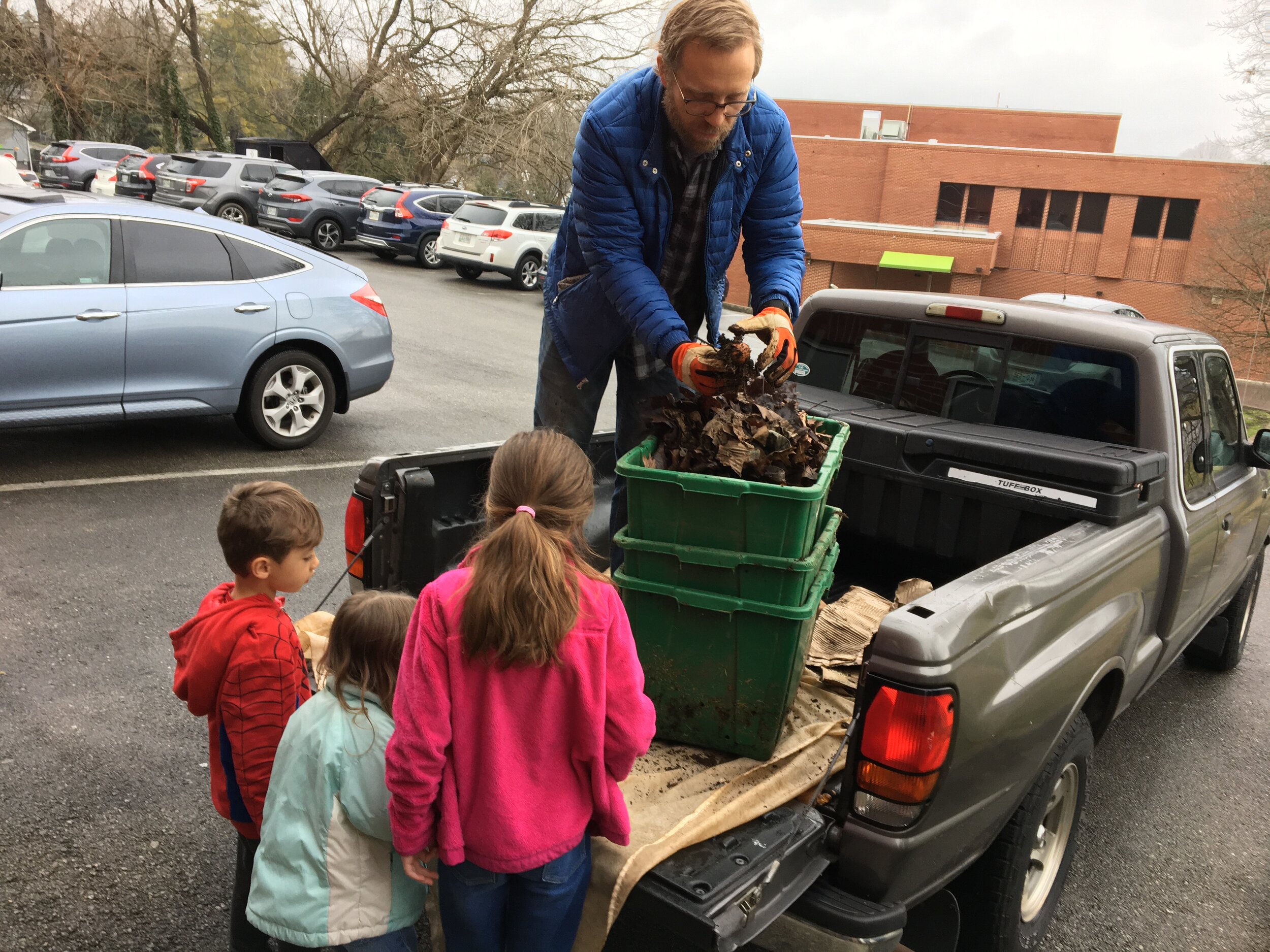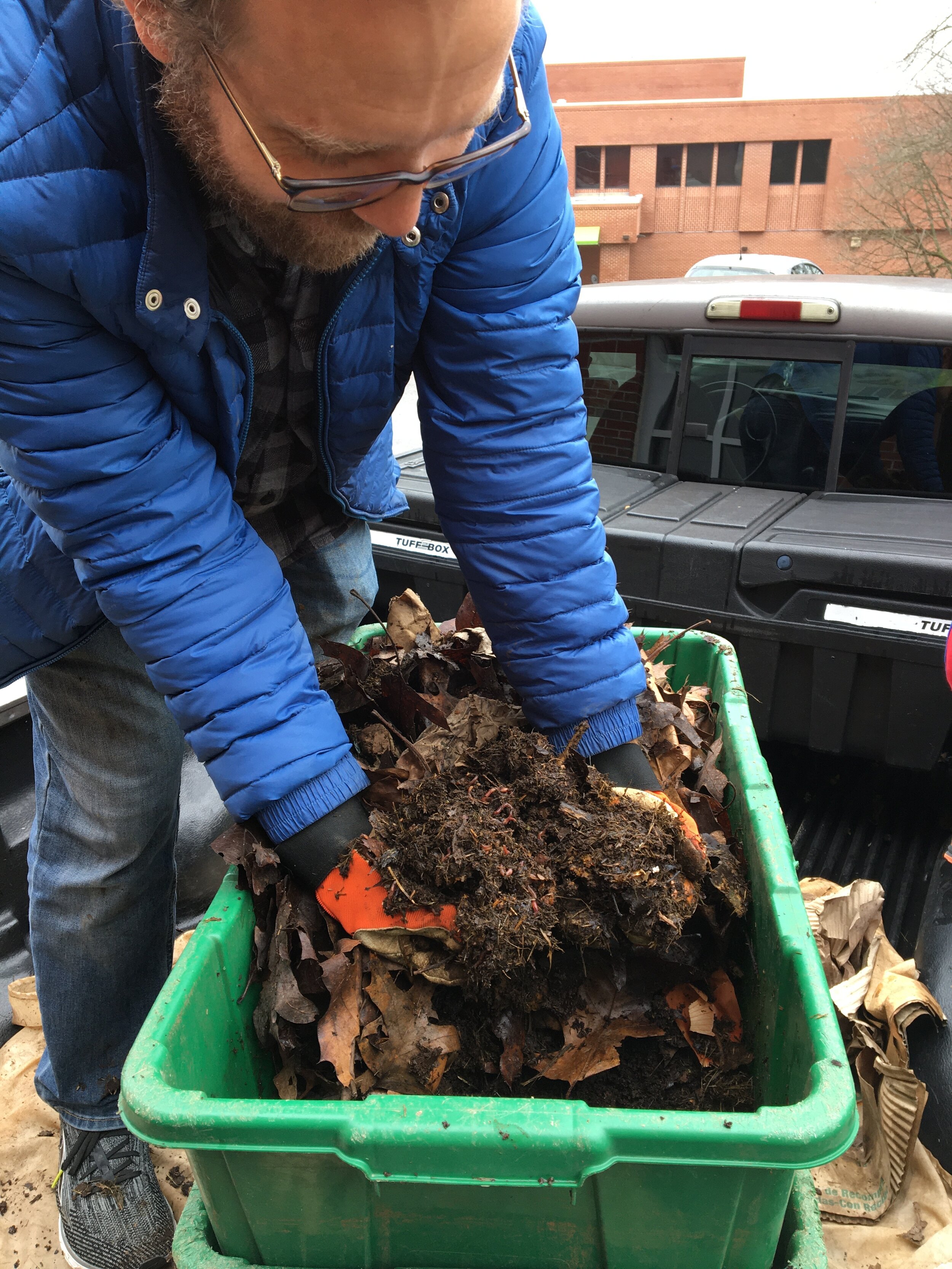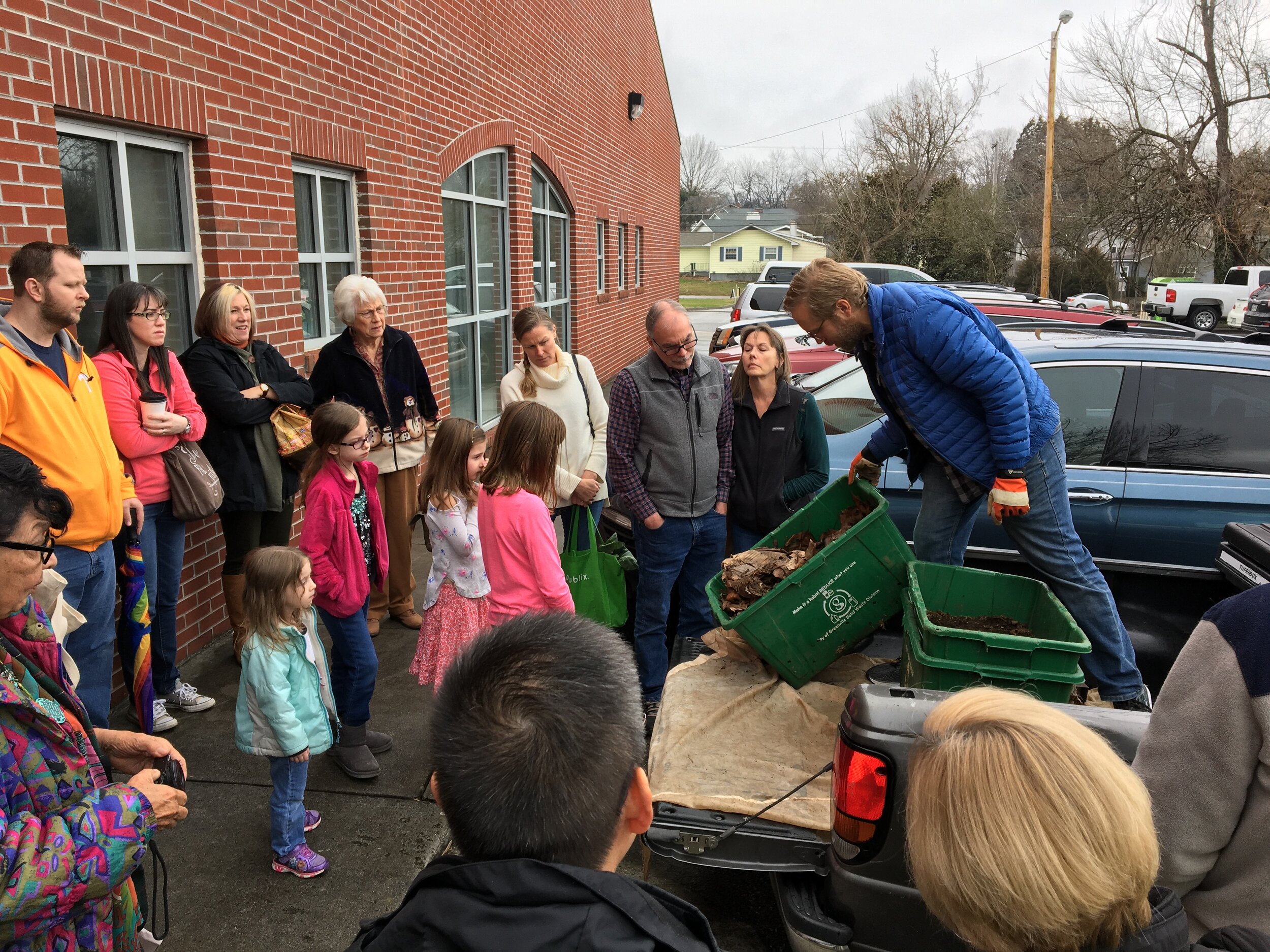
News from Grow Oak Ridge and its markets.
Recycling electronics, plastic bags, at Winter Farmers' Market
Look for this recycling box in front of the Winter Farmers’ Market, and also in front of The Ferrell Shop in Jackson Square.
Recycling drive at Winter Farmers’ Market during March
Electronics and plastic bags, for a new Jackson Square Trex bench
The Winter Farmers’ Market is hosting a recycling drive for electronics and plastic bags during the month of March, on Saturday mornings 9 a.m. to Noon, at the gym of St. Mary’s Catholic School, 323 Vermont Ave., Oak Ridge.
Old cell phones, computers, keyboards, tablets, radios, and other electronics will be collected in front of the market by local Oak Ridge business Atomic REC LLC. Owner Bradley Woodward collected electronics last year and customers have asked for his return. He will be outside from 9 to 11 a.m., March 6, 13, and 20 for collections.
In addition to electronics, market is collecting clean, dry household plastic bags during March, part of the NexTrex Recycling Program led by The Ferrell Shop of Historic Jackson Square. Produce bags, store bags, ice bags, Ziploc and other reclosable bags, cereal box liners, case overwrap, bread and newspaper bags and others are accepted at both The Ferrell Shop and the Winter Farmers’ Market.
No fast food bags or bags with food stains, please. No other items like cardboard, paper or glass will be accepted.
All plastic will be sent to NexTrex Recycling, which will donate a recycled plastic bench for Historic Jackson Square if 500 pounds of plastic can be collected. For more information about the bag recycling, call The Ferrell Shop at 865-483-0961.
The Winter Farmers’ Market is open through March 27 on Saturday mornings, for both in-person and online shopping. Contact-free, curbside pickup is offered in its Market-To-Go program. The market features local farmers, bakers and artisans, all of whom make, bake or grow what they sell within a 150-mile radius of Oak Ridge.
For more information about the Winter Farmers’ Market, or Market-To-Go, visit www.GrowOakRidge.org.
What can be recycled?
Plastic must be clean, dry
Market Recipe: Hearty Winter Vegetable Soup
Order These Ingredients: We’ve grouped all the veggies in this recipe together in our Market-To-Go online ordering system. Place your order by Thurs 12 PM for Saturday curbside pickup at the Winter Farmers’ Market, December through March, at St. Mary’s School.
This recipe is used with permission from Cook’s Country.
Thin, brothy vegetable soups can be satisfying, but in the dark days of winter we much prefer a hearty, creamy-textured vegetable soup chockablock with vegetables and beans. For a winning Hearty Vegetable Soup recipe, we cooked our winter vegetables until they were lightly browned and softened before adding them to broth. This gave them maximum flavor. Pureeing a portion of the soup helped to thicken it, and lightly toasted sandwich bread gave it a creamy texture without the heaviness of the cream. The jolt of a little balsamic vinegar helped clarify the Hearty Vegetable Soup’s complex flavor.
2 Tbs. vegetable oil
3 large carrots, peeled and cut into 3/4-inch pieces
2 large parsnips or turnips, peeled and cut into 3/4-inch pieces.
2 small onions, peeled and cut into 1/2-inch pieces.
6 cloves garlic, minced
8 cups low-sodium chicken broth (or vegetable broth)
2 medium russet potatoes, peeled and cut into 1-inch pieces
2 tsp. minced fresh thyme leaves (or 1 tsp. dried thyme)
1 sprig fresh rosemary
1 bay leaf
2 slices hearty white sandwich bread, lightly toasted
2 cups curly spinach, stemmed and chopped
1 14.5-oz can cannellini beans, drained and rinsed
1 10-oz package frozen baby lima beans or frozen peas
Balsamic vinegar
Salt and Pepper
Heat oil in a large heavy-bottomed pot over medium-high heat until shimmering. Add carrots, parsnips or turnips, and onios and cook until lightly browned and softened, 5 to 7 minutes. Add garlic and cook until fragrant, about 30 seconds. Add broth, potatoes, thyme, rosemary and bay leaf and bring to a boil. Reduce heat to low, cover and simmer until vegetables are soft, about 15 minutes. Remove rosemary and bay leaf. Transfer 3 cups solids, 1 cup broth and bread to blender and puree until smooth. Stir puree back into pot, add spinach, both types of beans, and stir until beans are heated through, about 8 minutes. Stir in 1 Tbs vinegar and season with salt and pepper to taste. Serve, passing extra vinegar at the table.
Still Waiting on Mushrooms
Be Patient. Don’t Panic.
Some of you may remember that we held our first ever Mushroom Inoculation Station on March 7, 2020.
EDITOR’S NOTE: We really remember this day well, because it was the last “normal” day of the market, before COVID-19 hit. It was a nice day, a full crowd, and we had such fun. Good times. Anyway…
We had hoped for mushrooms in the Fall of 2020. However, in chatting with a few of you it seems we have not had reports of shiitake mushrooms appearing yet. Maybe we will see some in Spring and Fall 2021. Please be patient. Keep watching. And let us know if you see any shiitake. It’s not unusual for a log to take two years to bloom.
Look out for competitive fungi.
Because we are growing outside and our growing conditions are not perfect, we are likely to see Turkey Tail and Split Gill Fungus. You can read more about competitive fungi on pages 27-29 in this report Best Management Practices for Log-Based Shiitake Cultivation. Let's hope that we avoid Trichoderma!
Please be patient. Below is a photo of a log that took two years to finally grow some shiitake. Hopefully our logs will grow mushrooms sooner than that.
Comment below and show us your mushroom log photos!
How to use Market-To-Go
OPEN NOV. 30 for DEC. 5 PICKUP!
From the home screen, click “Sign Up.” You will enter a credit or debit card to get started.
Shop Monday 12pm - Thursday 12pm
Sort by Producer, Product or Attribute (gluten free, for example), on the left. You can add or subtract items through Thursday 12 pm.
Click the + sign to add a product to your cart.
Confirm your order by Thursday at noon.
A $4 convenience fee will be added to each order (try it free with Coupon Code FREE1 at checkout!)
Saturday Pickup:
10 am to Noon - Covered entrance at St. Mary’s School gym, 323 Vermont Ave., Oak Ridge.
Pull up to the sign and call the phone number listed. Stay in your car.
A volunteer will bring it out to you. It’s that easy!
Mushroom Log Update
Does your mushroom log look something like this? That’s good!
Shiitake growers from our March 7 Mushroom Inoculation Station should see some evidence of whitish growth on the ends of their logs and around inoculation sites. This white mycelium shows us that the shiitake spawn has populated the log, the mushroom nutrient source. The presence of this whitish growth signals a possible shiitake harvest when the weather cools in the fall. Don’t worry if you do not see the mycelium yet. It might just take a little longer for your log to flush. Please get in touch if you have any questions.
This summer GROW your own food.
This summer, try growing your own food! Many crops can be grown from vegetables right from your fridge.
Editor’s Note: With COVID-19 limiting our ability to visit grocery stores, or requiring a mask to do so, many people are turning to growing their own food at home. We at Grow Oak Ridge encourage you do seek local sources for food this summer, and especially try growing your own. For information visit the Victory Garden Revival Facebook Group, or the East Tennessee Gardening Facebook group. If you’re interested in community gardening in Anderson County, please contact us.
***
By Patricia Alston
Patricia Alston is a resident of Oak Ridge, TN. She has coordinated and managed four community gardens.
You already have the beginning of a garden at home. Here are some fun and easy plants that you can grow right now.
Celery: The next time you cut the bottom inch off a stalk of celery, place it in a shallow cup of water on a sunny windowsill, leaving the top exposed. In a matter of days, you’ll notice fresh green growth emerging from the center. Change the water every couple of days and watch the plant flourish, even as outer stalks lose their color and fade. Once the new growth has established, transfer the growing celery into soil to continue its development.
Potatoes or Sweet Potatoes: Use about a quarter of a potato (a piece with two root eyes is ideal). Start it inside to watch, or place directly into the garden, eye side up. To reduce the chance of mold, keep it inside, let it dry out for a day. Place toothpicks into both sides of the potato piece, then place it on top of a glass of water. The toothpicks will hold some of the potato above water, but the eyes should be submerged. The roots will grow into the water and the leaves will grow toward the top. When there are enough roots, transfer and plant the garden.
Ginger: Use a piece of ginger with a knob, or one with an arm sticking out of the main body of the root. Soak the root overnight, then bury it in a pot of rich soil with good drainage. Be sure to keep the soil moist. Ginger does best in the shade or as a houseplant. It cannot tolerate cold weather or drought. If given the right conditions, ginger is easy to grow.
Green Onions: Cut off the bulb and roots (the white end) and place it roots down in a glass of water overnight. Replant outside or in a large pot the next day, and it will start growing quickly.
Leeks: Cut off the bulb, just like you would with green onions, and place it in a shallow glass of water. Change the water and wash the roots once a week. Harvest fresh leeks when they’re big enough to eat.
Romaine Lettuce: Cut off the bottom inch of a head of romaine lettuce. Place it roots down into a shallow glass of water, and new leaves will grow from the top.
Garlic: Plant a single clove of garlic root side down (flat end) into a few inches of potting soil. Once shoots start sprouting, cut them back so the bulb will be able to grow, and eventually you will have a fresh garlic bulb. Use a clove off the new bulb to start growing another for later.
Cabbage: Like celery, cabbage (as well as bok choy and romaine lettuce) can be regrown from the root base. Although cabbage can also be started in water, starting out in shallow soil is sometimes more effective. Make sure to keep the soil especially damp for the first week or two to encourage new growth.
Avocados: This has been a science project: the avocado pit is a giant seed ready to grow into your very own avocado tree. Press three toothpicks into the pit along its center and suspend it in a glass with water covering the bottom half. Change the water regularly and after a few weeks, stems will form. Growing this tree is a little more challenging than some other kitchen scrap projects, but is worth the effort.
Ginger: Ginger root are easy growers inside the house, but takes a little longer. Plant a piece of the rhizome (root) in damp soil and place in a sunny room, but out of direct sunlight. Shoots will become evident fairly soon, but it will take several months before there has been enough growth to harvest. Once the ginger has developed sufficient growth, pull the plant from the soil for use. Don’t forget to cut off a piece to re-plant!
Tip: Re-growing food is the perfect gardening activity for winter.
Making Simple Worm Bins Info
Making Simple Worm Bins
By Jason Schmidt
I am not a worm composting expert. Facts here may be incorrect or partially incorrect. Please ask me questions or search for answers elsewhere.
“Composting with Worms” from Mother Earth News
https://www.motherearthnews.com/homesteading-and-livestock/composting-with-worms-zbcz1903
A reliable “red wiggler” retailer: Uncle Jim’s Worm Farm https://unclejimswormfarm.com/
Composting turns food waste into nutrient-rich living soil for plants.
Our rejects, become something of value.
Composting with worms is relatively fast, less labor intensive than other methods of composting.
This information pertains to composting with Eisenia Fetida also known as “Red Wigglers”. Other species may have other needs. Some species are not suited for worm bin composting.
Worms need shelter, oxygen, moisture, food, and grit.
Shelter: bins made of plastic or wood work well. Many formats and ideas could work.
Oxygen: Air holes in containers, aeration of their “food”.
Moisture: Worms will move to find a moisture balance. Too dry, they will leave to find moisture
Too wet, they will move to breathe.
Food: Avoid meat, fat, dairy, fish. They do not seem to eat citrus fruits. They eat vegetables, leaves, paper, cardboard, grass clippings, coffee grounds, banana peels, tea. They need a diversity of foods. That is, too much paper is not nutritious for them. But too much pumpkin could cause harm, too.
Grit: Worms will use egg shells or grains of sand to grind food apart inside their crop. Without grit, they will not be able to break down larger bits.
Avoid climate extremes: Worms should not get too hot or too cold, too wet or too dry. My worm bin allows them to retreat underground a little bit for temperature extremes. It has drainage for rain events. I use materials that will hold moisture without drying out completely. You can help avoid climate extremes by choosing a location that does not get too extreme and by creative bin design.
Worm composting is not “hot” composting. If the compost heats up, try adding more carbon-rich, lower nitrogen material like shredded paper or cardboard. Dead leaves might help. But fresh leaves or fresh grass clippings will make the compost heat up worse. Aeration and additional moisture can help cool the pile down. But your worms will leave if the pile gets too hot for them.
Harvesting for outdoor applications: Harvest the moist dark black matter from the bottom of your bin by pulling back the uneaten material at the top of the bin. This black matter is decomposed organic material and worm castings (worm manure). Worms may leave behind eggs and baby worms along with the castings. That’s good for your outdoor plants, but it might be annoying for indoor plants.
Make sure you leave worms behind in your bin. Worms will naturally move into their uneaten food. So you can harvest the finished black stuff without devastating your worm population. Just make sure not to harvest all of your worms. Look through the bin for evidence that you still have worms to carry on future composting.
Harvesting for indoor applications: Worm “tea” may be a good option for feeding indoor plants to avoid worms hatching and moving around your house. I am not a worm tea expert. I just swirl some water around in my castings, allow the particles to settle, and carefully decant the dark water onto my houseplants.
Pests: flies, ants, cockroaches, raccoons
Fruit flies are inevitable in warm weather. Try keeping them at bay by varying the worm foods. Avoid too much of any one food type. Mix food well.
House flies/blow flies like odors such as those caused by anaerobic respiration. A good mix of food with more paper and leaves will reduce anaerobic conditions. Make sure to avoid foods that tend to stink when rotten (fish, meat, dairy). Keep food well mixed. Do not let things get too wet. Ventilation is key to avoiding anaerobic conditions.
Ants don’t like moisture. More than likely they have found a dry spot in the bin where they can harbor their eggs. A good soaking will cause them to move away.
Roaches are inevitable outside. Probably a mix of foods will keep them at a minimum. Maybe someone can share some secrets.
Watch out if you use pesticides. What is poisonous for the insects may be poisonous for the worms and the microbiological life they depend on for survival.
Outdoor animals: Cut things smaller and mix well. A raccoon will find other places to go if the food is a lot of work for them. Try to avoid strong odors. You might try using a heavier-duty lid or roof. Don’t forget that your worms need to breathe, so make sure any roof you have will ventilate the pile.
Observe and check on you worms occasionally. In the cold seasons, I might check them once per month. In warmer months, I harvest more frequently, so I keep an eye on them.
Red Wigglers are surprisingly resilient creatures. They can survive neglect.
Feel free to send questions to me. Email is best: jasonrschmidt@gmail.com
Give Me FIVE!
Attend the Winter Farmers’ Market five times this spring, and you could win prizes!
Attend the Winter Farmers’ Market FIVE times in February-March 2020, and you could win fun prizes!
The first 5 customers to attend 5 times get $5 in market tokens, good on any product in the market.
Any customer who attends 5 times by March 14 is entered to win one of FIVE market bags we’re giving away.
Enter at the Welcome Desk. Punch your card every week. Win 5!
Grow Oak Ridge receives 501(c)(3) status
We’re pleased to announce that Grow Oak Ridge has received 501(c)(3) status from the Internal Revenue Service, which means that any donations you make to it are tax deductible as the law allows. Support from donors is critical to our mission, which is to improve health in Anderson County, Tennessee, by connecting local farmers and locally grown food with the public. Like other tax-exempt charities, our Board is volunteer-led.
Grow Oak Ridge operates the Winter Farmers’ Market, opening Dec. 7, 2019 in the gym at St. Mary’s School, 323 Vermont Ave., Oak Ridge. It is the only farmers’ market in Anderson County that accepts SNAP benefits, commonly called food stamps. This year, the Winter Farmers’ Market will also be able to double SNAP benefits for fresh fruits and vegetables, up to $20 per day, in a program called Double Up Food Bucks. Please visit the Welcome Desk for more information.
The market also has a free children’s program called Power of Produce (POP) Club, in which kids take 2 bites of a vegetable, and get $2 to spend on fruits and vegetables in the market, as well as engage in nutrition educational games and activities.
To support Grow Oak Ridge and its programs, click here: https://www.growoakridge.org/support
4 Secrets to Farmers’ Market Quality
Four signs of farmers’ market quality. Here’s what you need to know as a customer or a vendor.
What makes a great farmers’ market?
Most people say, “Oh, I love my market!” and point to that favorite vendor who grows a variety of kale you can’t find anywhere else, or maybe your favorite band plays there regularly and you love to hear their music.
But from our perspective, good markets don’t just happen by accident! They’re PLANNED. Here are our 4 Signs of Farmers’ Market Quality, which of course … shameless plug…. you’ll find at the Winter Farmers’ Market by Grow Oak Ridge:
All the produce is locally grown
This is actually not as easy to determine as you would think. How do you KNOW If a farmer is REALLY growing those mushrooms, or buying them at a produce warehouse somewhere and selling them for twice as much?
Well, first you would need to recognize what’s in season. For example if you’re at a Winter Farmers’ Market and you see a farmer in the wintertime with red, ripe tomatoes, you know (we hope you know!) that tomatoes only grow in HOT weather… as in at least 80 degrees for them to wake up. So this is a good time to ask the farmer, “Where did you grow this?” Now, most farmers are going to talk extensively about their greenhouses, and how many heaters they have to keep running all winter long. In fact, most farmers go on. And on. And on about growing methods until your eyes start to glaze over! Good farmers’ markets also will investigate their vendors, either by calling references and extension agents, or by doing an on-site inspection. Ask the farmers’ market management how they know each product is local.
The Manager is NOT a Vendor
In a well-run market, manager is NOT a vendor. Why? Because, frankly, if you’re a successful farmer or artisan you’re probably working HOURS each day getting ready for the market on a Saturday. Plus, you also might be working a real job somewhere to pay the bills. You simply don’t have time to run a farmers’ market. If the market manager is also a vendor, then that market is probably not going to have much music, kids’ programs, a SNAP (food stamps) program, etc. There’s just no time. Find a farmers’ market is separate from the vendors, and you’ll find all those extra things that make a farmer’s market fun and not just a place to pick up locally grown veggies (although that’s important, too!)
Assigned Spaces
You bought those stringless green beans last month when you were here, but don’t remember the farmers’ name, but they were in the back left corner somewhere….. Does this sound familiar? Most customers do NOT remember a vendor’s name, and just want to find them in the same spot week after week. A good market manager will make sure this happens as much as possible. Some farmers’ markets have a “first-come-first-serve” attitude toward vendors, and it’s a free-for-all during set up time. This may be fine for vendors who have nothing better to do than arrive before dawn for an 8 a.m. start, but again, professional farmers are BUSY. A farmers’ market that does not assign spaces also probably has vendors who are annoyed or downright angry with each other. You the customer might not notice it, but you will notice over time that the biggest, best vendors stop coming. Why? They’re just too busy to arrive 3 hours before set up and stake out a “good” spot. They’ve moved on to other markets that assign spaces!
Welcome Desk
Finally, the best farmers’ markets have a Welcome Desk for customer service. This is where the manager or assistant sits during the market, helping customers with things like SNAP (food stamps) EBT cards, maybe an ATM-like system in which customers who forget to bring cash can purchase market tokens, or maybe there’s a kids’ program, and more. When all the other vendors are so busy with their own booths, it’s a great idea to have a Welcome Desk to watch out for customer needs.
And that’s it, folks, our Top 4 Marks of a Great Farmers’ Market!
If you’re a vendor who makes, bakes or grows what they sell, consider applying for the Winter Farmers’ Market by Grow Oak Ridge.
National Farmers' Market Week, Aug. 4-10
The Winter Farmers' Market opens Dec. 7, 2019, but we are hard at work planning our next winter season, which will run December 2019 through March 2020!
First, we are proud to serve Anderson County by accepting and doubling #SNAP benefits up to $20 per day for fresh fruits and veggies. Did you know 20% of our city receives SNAP and cannot shop easily at the market otherwise?
Second, we also donate 10% of vendor fees to a local food bank.
Third, we offer a FREE weekly program called the Power of Produce Club (POP Club) for children. If a child takes 2 bites of a veggie, they get $2 to spend on fruits & veggies in the market.
These are our ways of giving to the Oak Ridge community, and promoting health by connecting local farmers to the public!
VENDORS - Applications will be online soon at www.GrowOakRIdge.org.
#loveoakridge #youarewhatyoueat #growoakridge #exploreoakridge#eathealthy #eatfresh
















